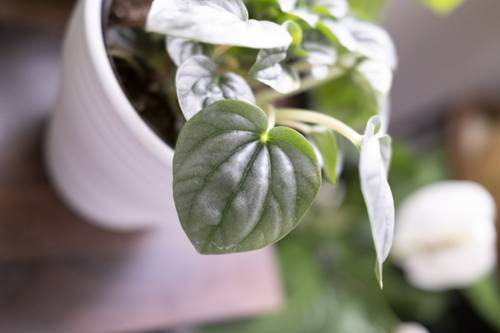
FAQ About How to Revive a Neglected Houseplant

What are the first steps to take when reviving a neglected houseplant?
Start by assessing the current condition of the plant, including its leaves, stems, and soil. Remove any dead or yellowing leaves, and cut back any parts that are clearly beyond recovery. Check for signs of pests or diseases that might need attention. Finally, decide on the next steps based on the plant's specific needs, such as watering, repotting, or pruning.

How can I tell if my houseplant is still alive?
To determine if your plant is still alive, look for any green tissue on the stems or stalks, which indicates life. Gently scrape the stem with your fingernail; if you see green beneath the surface, the plant is likely alive. Additionally, check the roots for any signs of vitality; healthy roots are usually firm and white.

What should I do if my houseplant is overwatered?
If your plant is overwatered, first remove it from the pot and gently shake off excess soil. Allow the roots to dry by placing the plant on a paper towel or newspaper for several hours. Repot the plant in fresh, well-draining soil and ensure the pot has drainage holes. Reduce watering frequency and monitor for signs of recovery.

How do I know if my plant is underwatered?
Signs of an underwatered plant include wilting, dry or brittle leaves, and soil that feels completely dry to the touch. If you suspect underwatering, gradually reintroduce water to the plant. Begin with a thorough soak and ensure the soil is absorbing moisture. Consistent watering on a regular schedule will help prevent future issues.

What type of soil is best for repotting a neglected plant?
The best soil for repotting depends on the type of plant. Generally, a well-draining potting mix is suitable for most houseplants. For cacti and succulents, use a mix with more sand or perlite, while tropical plants might prefer soil rich in organic matter. Ensure the pot also has adequate drainage holes to prevent waterlogging.

How can I improve the humidity level for a struggling houseplant?
To improve humidity, mist the plant regularly, place it on a tray filled with pebbles and water (without submerging the pot), or use a humidifier in the room. Grouping plants together can also increase ambient humidity around them, which is beneficial for plants needing more moisture in the air.

Are there signs that indicate a plant is beyond recovery?
A plant is likely beyond recovery if all stems are brittle and brown, there is no green tissue, roots are mushy or entirely rotted, and pests or diseases have extensively damaged the plant. In such cases, it may be best to dispose of the plant to prevent any potential issues from affecting nearby plants.

What should I do if I find pests on my neglected houseplant?
If pests are present, first isolate the affected plant to prevent spreading. Remove any visible insects or eggs by hand or with a gentle spray of water. Use an insecticidal soap or a homemade solution of water and dish soap to treat the remaining pests. Ensure to follow application instructions carefully.

How often should I water a revived houseplant?
The watering frequency for a revived plant depends on its type, size, and environment. Generally, ensure the top inch of soil is dry before watering again. This might mean watering once a week for many houseplants, but always tailor to the specific needs of the plant and conditions, adjusting as necessary.

What is the best way to prune a neglected plant?
Begin pruning by removing dead, damaged, or diseased parts of the plant with clean, sharp scissors or pruning shears. Focus on shaping the plant to encourage new growth and airflow. For plant-specific pruning instructions, research the best practices for the particular species to avoid unwanted damage.

How much light does a recovering plant need?
Most recovering plants benefit from bright, indirect light. Direct sunlight can be too intense and may cause additional stress. Adjust light levels based on the plant's typical requirements and observe how it reacts, adjusting its position if necessary to find a suitable balance.

Should fertilizers be used when reviving a houseplant?
Fertilizers should be used cautiously. Initially, focus on giving the plant the right water and light conditions. Once it's showing signs of new growth and recovery, introduce a balanced, diluted fertilizer to provide additional nutrients. Over-fertilizing can harm a weak plant, so observe its response closely.

Is it necessary to change the pot when reviving a plant?
Repotting might be necessary if the current pot is too small, if the roots are crowded, or if the soil is poor. When repotting, choose a slightly larger pot with good drainage and fresh soil. Be gentle with the roots to avoid additional stress during the process.

What tools are needed to care for a neglected houseplant?
Basic tools for caring for a neglected plant include pruning shears, gloves, a trowel for soil work, and a watering can. Additional items like a humidity tray, insecticidal soap, or a small hand-held rake for aerating the soil can also be beneficial for more comprehensive care.

How long does it typically take for a neglected plant to recover?
The time for recovery varies significantly based on the type of plant and the extent of neglect. Some plants show improvement within weeks, while others may take several months. Consistent care tailored to the plant's needs will aid in a quicker and more successful recovery.

What are common mistakes to avoid when reviving a houseplant?
Avoid overwatering or underwatering as both can harm a weakened plant. Don't move the plant to drastically new conditions all at once, and avoid using too much fertilizer too soon. Monitoring the plant's progress and making gradual adjustments is key to successful revival.

Can moving a plant to a new location help with its recovery?
Yes, relocating the plant to an area with more appropriate light or humidity can benefit its recovery. However, avoid shocking the plant by moving it repeatedly or to extreme conditions quickly. Gradual changes are best for allowing the plant to adjust comfortably.

Is it possible to propagate from a neglected plant?
Propagation is possible if some parts of the plant remain healthy. Take cuttings from the healthiest sections of the plant, ensuring they have leaves and part of the stem. Use rooting hormone to encourage root development and plant them in suitable soil under favorable conditions for new growth.

How can I prevent future neglect of my houseplants?
To prevent future neglect, establish a regular care routine including watering, light exposure monitoring, and scheduled check-ups for pests or disease. Use reminders or apps if necessary, and ensure the plant's conditions match its natural habitat as closely as possible for optimal health.

Why is the soil condition important in reviving a plant?
Soil condition directly affects the plant's ability to absorb water and nutrients. Degraded or compacted soil may suffocate the roots and impede recovery. Using fresh, well-aerated, and appropriate potting soil helps ensure the plant receives the nutrients and moisture it needs for optimal revival.
